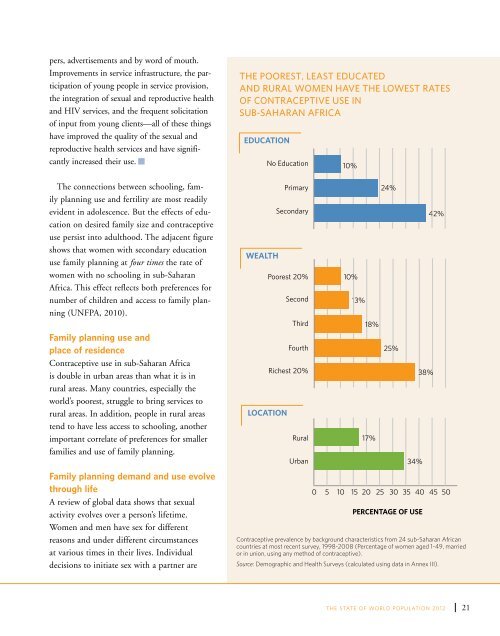State of World Population 2012 - Country Page List - UNFPA
State of World Population 2012 - Country Page List - UNFPA
State of World Population 2012 - Country Page List - UNFPA
You also want an ePaper? Increase the reach of your titles
YUMPU automatically turns print PDFs into web optimized ePapers that Google loves.
pers, advertisements and by word <strong>of</strong> mouth.<br />
Improvements in service infrastructure, the participation<br />
<strong>of</strong> young people in service provision,<br />
the integration <strong>of</strong> sexual and reproductive health<br />
and HIV services, and the frequent solicitation<br />
<strong>of</strong> input from young clients—all <strong>of</strong> these things<br />
have improved the quality <strong>of</strong> the sexual and<br />
reproductive health services and have significantly<br />
increased their use.<br />
The connections between schooling, family<br />
planning use and fertility are most readily<br />
evident in adolescence. But the effects <strong>of</strong> education<br />
on desired family size and contraceptive<br />
use persist into adulthood. The adjacent figure<br />
shows that women with secondary education<br />
use family planning at four times the rate <strong>of</strong><br />
women with no schooling in sub-Saharan<br />
Africa. This effect reflects both preferences for<br />
number <strong>of</strong> children and access to family planning<br />
(<strong>UNFPA</strong>, 2010).<br />
Family planning use and<br />
place <strong>of</strong> residence<br />
Contraceptive use in sub-Saharan Africa<br />
is double in urban areas than what it is in<br />
rural areas. Many countries, especially the<br />
world’s poorest, struggle to bring services to<br />
rural areas. In addition, people in rural areas<br />
tend to have less access to schooling, another<br />
important correlate <strong>of</strong> preferences for smaller<br />
families and use <strong>of</strong> family planning.<br />
Family planning demand and use evolve<br />
through life<br />
A review <strong>of</strong> global data shows that sexual<br />
activity evolves over a person’s lifetime.<br />
Women and men have sex for different<br />
reasons and under different circumstances<br />
at various times in their lives. Individual<br />
decisions to initiate sex with a partner are<br />
The poorest, least educated<br />
and rural women have the lowest rates<br />
<strong>of</strong> contraceptive use in<br />
Sub-Saharan Africa<br />
EDUCATION<br />
WEALTH<br />
No Education<br />
Primary<br />
Secondary<br />
Poorest 20%<br />
Second<br />
Third<br />
Fourth<br />
Richest 20%<br />
LOCATION<br />
Rural<br />
Urban<br />
10%<br />
10%<br />
13%<br />
18%<br />
17%<br />
24%<br />
25%<br />
34%<br />
42%<br />
0 5 10 15 20 25 30 35 40 45<br />
PERCENTAGE OF USE<br />
38%<br />
Contraceptive prevalence by background characteristics from 24 sub-Saharan African<br />
countries at most recent survey, 1998-2008 (Percentage <strong>of</strong> women aged 1-49, married<br />
or in union, using any method <strong>of</strong> contraceptive).<br />
Source: Demographic and Health Surveys (calculated using data in Annex III).<br />
50<br />
THE STATE OF WORLD POPULATION <strong>2012</strong><br />
21
















